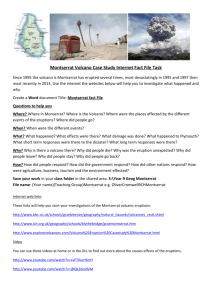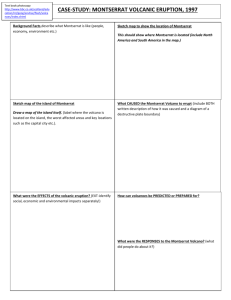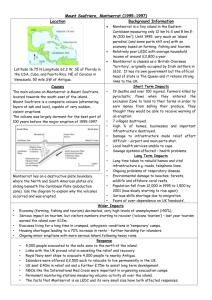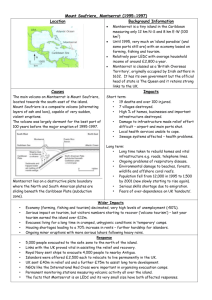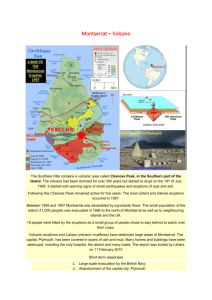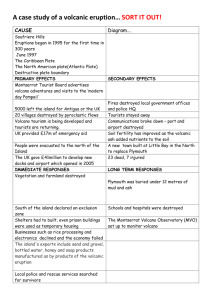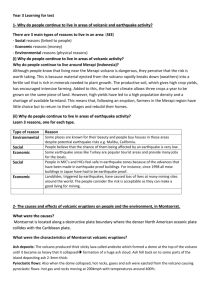Dr Anthony Carrigan - University of Warwick
advertisement
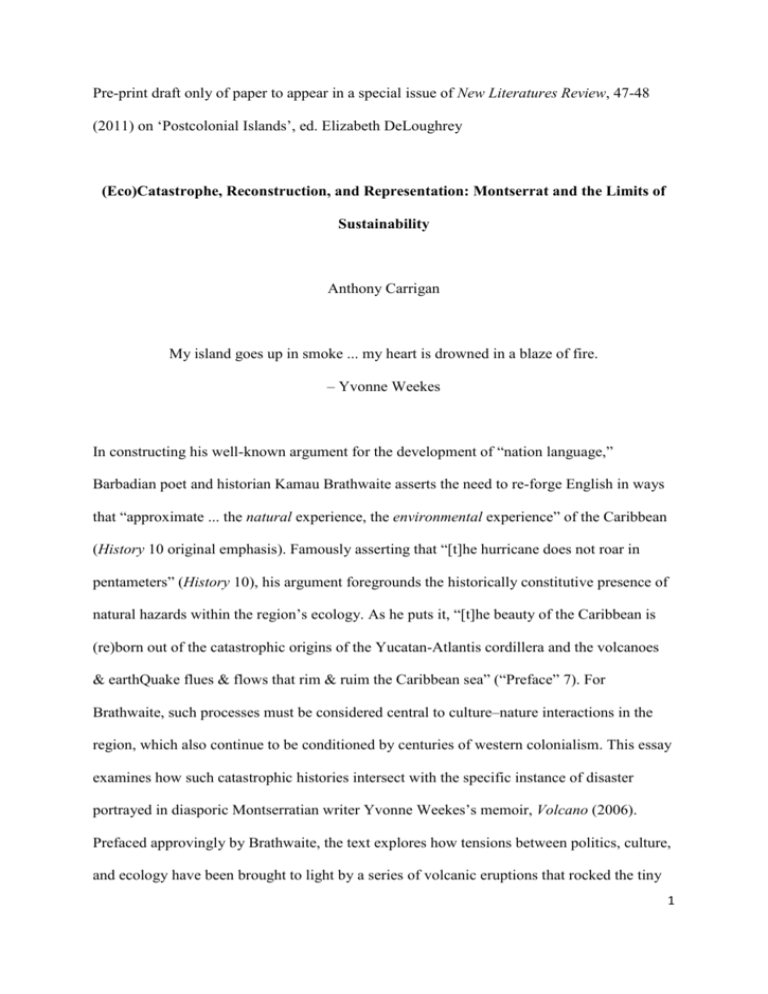
Pre-print draft only of paper to appear in a special issue of New Literatures Review, 47-48 (2011) on ‘Postcolonial Islands’, ed. Elizabeth DeLoughrey (Eco)Catastrophe, Reconstruction, and Representation: Montserrat and the Limits of Sustainability Anthony Carrigan My island goes up in smoke ... my heart is drowned in a blaze of fire. – Yvonne Weekes In constructing his well-known argument for the development of “nation language,” Barbadian poet and historian Kamau Brathwaite asserts the need to re-forge English in ways that “approximate ... the natural experience, the environmental experience” of the Caribbean (History 10 original emphasis). Famously asserting that “[t]he hurricane does not roar in pentameters” (History 10), his argument foregrounds the historically constitutive presence of natural hazards within the region’s ecology. As he puts it, “[t]he beauty of the Caribbean is (re)born out of the catastrophic origins of the Yucatan-Atlantis cordillera and the volcanoes & earthQuake flues & flows that rim & ruim the Caribbean sea” (“Preface” 7). For Brathwaite, such processes must be considered central to culture–nature interactions in the region, which also continue to be conditioned by centuries of western colonialism. This essay examines how such catastrophic histories intersect with the specific instance of disaster portrayed in diasporic Montserratian writer Yvonne Weekes’s memoir, Volcano (2006). Prefaced approvingly by Brathwaite, the text explores how tensions between politics, culture, and ecology have been brought to light by a series of volcanic eruptions that rocked the tiny 1 Eastern Caribbean island of Montserrat over the last fifteen years. Historically, Montserrat has faced similar challenges to many other postcolonial island states, including the need to foster cultural growth in relation to lived experiences of diaspora and displacement, and to negotiate conflicts over land-use within topographically bounded space. However, the volcano has tested the limits of post-disaster sustainability—both social and environmental— as mass depopulation and flawed crisis management initiatives threatened to leave Montserrat a deserted isle. The depopulation and environmental devastation caused by ongoing volcanic activity could be seen as paradigmatic of how small islands’ supposed “fragility” is exposed by large-scale catastrophes, as limited resource bases, dependence on external aid, and inducements to migrate restrict capacity for recovery. Yet rather than submit to a “fatal impact” interpretation of the volcano’s effects, Weekes’s memoir juxtaposes personal experience with research from the field of disaster studies to highlight how conditions of social and historical vulnerability have caused this environmental hazard to be realised as a catastrophe. In so doing, it provides conceptual orientation for cultural and material reconstruction, and helps to refine how disaster studies principles are applied both to this ambiguously postcolonial island state and within the region more broadly. From Hurricane to Volcano: (Eco)Catastrophe in Montserrat In recent years, two high-impact environmental events have devastated Montserrat, presenting severe challenges for post-disaster recovery. The first occurred in September 1989, when the island was struck by Hurricane Hugo. For Montserratian poet and historian Howard Fergus, the hurricane was “[a] wraith wrapped in grey clouds”—a category 5 monster which the then Governor of Montserrat, Christopher Turner, termed “the worst natural disaster experienced by any Caribbean island during the last 80 years” (Markham and Fergus 5). It flattened ninety percent of local infrastructure, leaving virtually all of the 2 island’s 12,000 residents homeless, and caused an estimated $100–300 million of damage, making the island reliant on foreign aid (“United Kingdom—Montserrat”). This brought some of the contradictions associated with Montserrat’s status as a British Overseas Territory into sharp relief. As Tracey Skelton points out, although the island “gained more selfgovernment” in relation to the UK in 1960, it declined “associated statehood” following the West Indian Federation’s collapse in 1962 as this would have involved “an alliance with St Kitts, Nevis and Anguilla, with St Kitts in charge.” Instead, it “remains one of the oldest British colonies” (107). While there are benefits in retaining UK affiliation, Montserrat’s colonial status presented difficulties in appealing for wider international aid following Hugo. This had political ramifications, as “the British Governor invoked emergency colonial orders which passed day-to-day control of the island away from the locally-elected Chief Minister” (Skinner 57). Ironically, the perceived generosity of Britain coupled with instances of internal corruption functioned to quell pro-independence movements subsequent to the hurricane. Indeed, Reuben Meade, who was then Minster of Finance and Planning and has gone on to become Chief Minister, even claimed that the island “needed a disaster just once to ... bring us back into focus with ourselves” and retain a sense of community in the face of increased materialism (Markham and Fergus 70). Although Montserrat recovered admirably from the disaster in material terms—achieving a budgetary surplus by 1995 (Skelton 114)—its continued status as an Overseas Territory had disenfranchising effects with respect to the second major disaster to affect the island: the serial eruption of its Soufriere volcano. Considered dormant throughout recorded history, Montserrat’s volcanic peak, Mount Chance, erupted dramatically in July 1995. This was followed by the disastrous eruption of 1997, which claimed nineteen lives, and further activity into the 2000s. Whereas post-Hugo reconstruction efforts were seen largely as a triumph over environmental adversity, the volcano’s effects were catastrophic. The island’s capital, Plymouth, was buried under ash and 3 rendered uninhabitable, and two-thirds of the population emigrated following the 1997 eruption. Most of the south of the island has been designated an official exclusion zone, with all remaining inhabitants forced to resettle in the north (Figures 1 and 2 highlight the volcano’s biogeographical predominance in Montserrat and the scale of the exclusion zone). This fragmented what had previously been a cohesive and prosperous community, experiencing “good levels of employment, high standards of health care and education provision, ... and ... one of the highest standards of living in the Caribbean ... as a whole” (Skelton 104). At the start of her memoir, Weekes observes that Montserrat “has always been the world’s best-kept secret,” continually being “discovered and then forgotten”—she even recalls how one of her British teachers in the 1960s produced a globe in class to “prove” to her that “[t]here is no such place” (16–17). The volcano’s dramatic and unexpected activity has decisively changed this, placing the thirty-nine square kilometre island firmly on the map as a site of global scientific interest and disaster reportage. 4 Fig. 1 Aerial view of Montserrat (Credit: NASA Visible Earth) Fig. 2 Map of Exclusion Zone (Credit: Montserrat Tourism Board) Responding to these events, Volcano interrogates a form of alienation between culture and nature that is distinct from but linked to the broader sense of rupture engendered by the region’s plantation histories.1 On one level, Weekes’s generically innovative memoir provides a politicised yet visceral insight into how “[t]he island’s ambiguous and fragile political situation as a British colony ... compounded the harsh realities of living with a volcano” (Skelton 105–6). On another level, her decision to name the text after the volcano and to structure it around its presence positions the disaster as intrinsic to self-representation. Volcano can therefore be aligned with other examples of postcolonial life-writing in the way it displaces individual narrative—often associated with the normalising white, male, bourgeois subject in western autobiography—in favour of collective concerns. But the text 5 also presents a profoundly ecological notion of selfhood, evoking a similar “poetic relation with land” to other environmentally oriented examples of Caribbean literature that counter the “erasures” caused by “colonialism[,] ... deterritorialisation and transplantation of peoples, and even natural disasters” (DeLoughrey, Gosson, and Handley 3). Volcano situates the encounter between “natural” disaster and colonial processes of dispossession at the heart of its negotiations of personal and social reconstruction strategies. This speaks strongly to the environmental rationale of Caribbean “nation language” as conceived by Brathwaite, highlighting how disasters function simultaneously as moments of erasure and opportunity. Ecological Life-Writing, Volcanic Agency, and Crisis Management Born in London to Montserratian parents in 1958, Weekes begins her narrative by describing her estrangement from British culture and her profound feelings of connection with Montserrat. She spent several formative years on the island when she emigrated with her parents in 1967, returning again to the UK in 1973 where she continued to study at university before taking up permanent residence in Montserrat in 1987.2 Despite her dual affiliation, Weekes dismisses “all that England stuff” as “the dry period,” asserting that Montserrat, “with its deep black sands glittering as if diamonds were embedded in them, with its brilliant waters and saw-toothed mountains is” and “will always be home” (18). Her sense of rootedness in relation to the island is nevertheless strongly inflected by her experiences as a diasporic inhabitant. According to Weekes, “the villagers who live and work in the South and East” of Montserrat not only “recognise” the volcano’s “every curve and bend” but are also aware that “something is wrong even before the scientists who come to explore and examine” (19). By contrast, she acknowledges that “[i]n all the years growing up and living on the island of Montserrat, I never once remember thinking about” the volcano. Such separation partly underpins the sense of ontological rupture she feels when “the earth starts rumbling” 6 (19). As Weekes puts it, “I don’t remember even noticing her. ... I only know that she came into my consciousness when she blew that hot July in 1995. ... This then is the beginning of time” (15 original emphasis). Standing as an independent paragraph on the memoir’s first page, the final sentence of this quotation is important from a formal perspective as the volcanic eruption also signals the beginning of narrative time. Moreover, by gendering the volcano, Weekes introduces an interrogation of identity that is constructed in relation to feminised nature. The personal orientation of this distinguishes the text from broader social histories, with the volcano becoming constitutive of Weekes’s first-person, present-tense exploration of post-disaster selfhood. Yet by reflecting on her own experiences, Weekes simultaneously offers productive insights into material and psychological reconstruction on a communal level. Throughout her memoir, Weekes consistently anthropomorphises the volcano, ascribing it agency as a malign presence. She compares it to “a spoilt child ... a spiteful mother ... [o]r ... a vengeful god” (42)—a “hateful ... mountain that has interrupted my calm existence in paradise” (64) and “covered” the island in “venom” (106). At times the volcano is imagined as causing what Weekes terms “the Montserrat disease” (72)—engendering trauma on a psychic level while simultaneously threatening the physical health of those who decide not to flee the island. “The volcano batters us,” Weekes writes of the interim between the 1995 and 1997 eruptions, creating an environment in which it seems “as if the world is no more than defecation” (59). There is a strongly apocalyptic dimension to Weekes’s commentary on how the volcano represents “the total destruction of our lives” (87), transforming large parts of Montserrat into wasteland, as ash “falls like bullets on the galvinize roof[s]” (51) and “all that emerald [is] turned / to deathly white” (96). These torrid descriptions underline the physical hardship afflicting all who remained on the island, as those moving to the north were forced into temporary shelters with inadequate sanitation and 7 medical facilities. This is accompanied by the psychological distress of living in a situation of prolonged vulnerability. Weekes writes that, while she feels “sick of the constant taste of sulphur in the back of my throat ... sick of the ash,” most of all she is “sick of the waiting: the waiting to see whether our lives will ever get back to normal, the waiting to make plans for the future. I am sick of that mountain controlling my life” (62-3). The distress Weekes expresses here is critically exacerbated following 1997’s fatal eruption as, “haunted by the faces of the people I know who have lost their lives, their homes, their loved ones,” she describes “feel[ing] helpless and powerless ... deeper than grief” (72). It is these emotions that provoke the anguished sentiment, taken from one of the poems embedded in the narrative, which serves as the epigraph to this essay. Yet rather than allow her narrative to become bracketed as an account of individual trauma, Weekes’s consistent feminisation of the volcano is foundational to how she depicts the boundaries between diasporic selfhood and ecological process as shifting and porous. In the memoir’s opening, for instance, Weekes writes: “I become fascinated with the mountain. She looks beautiful and majestic. She looks bigger, enthralling. I realize how little I really know about her” (21). By creating a sense of slippage between environmental “fascination” and self-scrutiny, Weekes’s text puts pressure on sharp distinctions between herself and the feminised mountain. Instead of fashioning the kind of subjective unity or coherence that typifies canonical autobiography, she interrogates how her identity is formed in relation to an often contradictory human–environmental interface. This creates a platform for redressing the overwhelming sense of social fragmentation that appears on the surface to be caused by the volcano. Weekes recognises that “[t]he mountain has left me in a state of imbalance” (82)—a phrase that applies to Montserrat at large as, “[s]cattered and dispersed all over this world, we have become a landless people, living in conditions that we could never have imagined” (92). 8 Instead of dwelling on a bleak and rootless future, however, she reconfigures feelings of helplessness and vulnerability by combining political activism with academic research and creative writing. Although Weekes continues to describe the mountain as being “in cahoots with the British” and “the total destruction of our lives” (87-8), she also states that as “[t]he mountain is doing her thing again ... the volcano within me starts raging” (77). This prompts her to direct her indignation less at environmental processes than at human actions, asserting that “it is too simple to blame the mountain” (83). She writes that: The mountain inspires me. Over the next few weeks ... I read everything I can get my hands on about crisis management. ... All I read confirms what I instinctively know. Those who must be blamed for the deaths are those who failed to manage the crisis. ... The present set of managers need to acknowledge that their mismanagement is the cause of the mass exodus of Montserratian people from the island. It is their mismanagement that has caused more lasting harm to Montserrat than the Langs Soufriere. (82-5 original emphasis) Weekes’s conviction that population exodus and dispossession is causing “lasting harm” to the island is provocative as it prompts consideration of how Montserrat’s political status— and the poor crisis management associated with this—has undermined successful reconstruction by augmenting community fragmentation. Although the constant inundation of ash made living conditions unbearable for many, collective suffering was significantly exacerbated by inadequate provisions for displaced people following the first eruption. Weekes recalls how the British-appointed governor of the island, Frank Savage, announced “that anyone who feels uncomfortable about remaining on the island can go to England for two years. The British Government promises to provide assistance when they arrive” (63). Residents were also offered 10,000 Eastern Caribbean dollars (worth between one half and one third of a US dollar) “to resettle in other islands in 9 the region” (87). Weekes calls “[t]he whole assistance deal … a scam, a fraud” (93), using disaster studies research to support her assertion that, “[b]y not providing adequate alternative[s] ..., every single manager of this crisis failed to understand the ‘enormous psychosocial and practical importance of homes’” (83).3 This is significant firstly because it highlights an island-specific point regarding social vulnerability to natural hazards: not only were individual homes destroyed but the whole state has been rendered “unhomely” by volcanic transformation and inadequate reconstruction efforts. Secondly, it raises the question of whether external crisis managers with vested interests in the island were in fact ignorant of the importance of homes, given that this “failure” contributed to expediting depopulation. By promoting migration over reconstruction, the British government attempted to limit liability for ongoing financial support, the costs of which prompted Minister for International Development Clare Short’s infamous comment that Montserratians would soon be demanding “golden elephants” (“Short Defends Handling of Montserrat”). This incentivised foreign resettlement policy could therefore be considered as a form of “assisted migration.” Also known as “assisted colonisation,” assisted migration is a biological term that refers primarily to transplantation of plant species in response to climate change. I use it in this context to underline the human agency involved in Montserrat’s depopulation—a process of deliberate investment reduction which British authorities have tried to naturalise.4 As Weekes recognises, such naturalisation deflects agency away from the “planners and implementers for colonial policy” for whom relocation would “cost ... [virtually] nothing” (88) in comparison to sustainable reconstruction. It also increases external control over Montserrat as a site of knowledge production. The initial eruption was an invitation for scientists from around the world to descend on Montserrat, conducting “seemingly high-level discussions about which people are very suspicious,” particularly as they are often limited to “the Governor and a set of White scientists” (24). Returning to Montserrat in January 1996, 10 following a short spell studying for her Master’s degree in Antigua, Weekes observes how the initial “buzz” regarding “racism in the Volcano Observatory” had been substantiated by the fact that “there is not a single black scientist at the ... observatory any more” (69). She connects this with wider processes of dispossession, telling the Chief Minister “that I have no intention of living on a plantation ever again” (69) and wondering “if I ever want to go back to Montserrat,” when “all the black scientists have left” and “everything ... is being run by the British” (71). Instead of relinquishing interest in the island, however, her polemical lifenarrative highlights how autonomy can be reasserted in the face of exploitative disaster management by countering the erasures of assisted migration. It demonstrates how localised narratives of transformation testify to a history of culture–nature interaction which must not be lost as post-disaster Montserrat is appropriated as a scientific laboratory and a site for disaster tourism. Cyclical Histories and Post-Disaster Narrative As befits a narrative in which ecological subjectivity is a central concern, Weekes focuses in her conclusion on the importance of regenerating human–environmental reference points on the island. Refusing to interpret the eruption and consequent exodus in apocalyptic terms, she turns, like Brathwaite in Volcano’s preface, to regional cycles of destruction and renewal. In one of the text’s poems, Weekes writes: “The smell of sulphur rises through the earth. / This is the beginning of the end, / the dying of an old time” (102). These lines point simultaneously to an ending without possibility of redemption (she goes on to describe exiled Montserratians “looking for a saviour / who cannot be resurrected” [103]) and to alternative temporalities, with the use of the indefinite article to describe “old time” suggesting that this is a context-specific rather than a universal concept. Volcano then proceeds to present Weekes’s own figurative demise, as her profound feelings of loneliness and loss cause her to 11 announce: “I die. The mountain has killed me” (106). Although this appears to reinforce collective narratives of social rupture, her “death” paradoxically forms part of a healing process which is necessary for creating new conceptions of island life. The text’s climactic ending involves a moment of volcanic radiance in which the function of narrative also becomes essential to achieving the conditions for post-disaster recovery. Realizing that “there is an ash of death and ash of rebirth” (109), Weekes concludes Volcano as follows: I get over the Montserrat blues. ... I remember Mama … told me once that when the volcano goes back to sleep, the land is going to be fertile and rich and we’ll be able to plant even more food than before. … So I know I must not give up … I can either brood over my loss, or build a new Montserrat, a Montserrat full of my Mama’s stories … I will rise out of the ashes. This testimony is my own affirmation. Is my rebirth out of those ashes. … [T]here is still a brilliant sun ahead. This is the beginning of a new time. (110–11) Weekes’s conclusions point towards a form of “consilience” (a term used by biologist E.O. Wilson to denote epistemological synthesis) between herself and the volcano. As she observes prior to this conclusion, “No matter how powerful the mountain is, she cannot destroy what I plant in my heart. ... I can allow it to sustain me or I can allow it to oppress me” (110 my emphasis). This emphasises how the destruction wrought by disaster can be reconfigured in ways that help “sustain” cultural identity at the beginning of another temporal and ecological cycle (“a new time”). In raising this possibility, Weekes also evokes comparison with the sacred firebird, the phoenix, ascending from the literal ashes of scorched Montserrat with renewed life.5 This creates a productive dialectic between human and environmental timeframes, reinforcing Brathwaite’s assertion that “[t]he beauty of the Caribbean is (re)born out of ... catastrophic origins” (“Preface” 7). The theme also resonates 12 with other examples of post-volcano writing from Montserrat: as Fergus concludes in his poem, “Volcano Watch,” “Some of us plan to storm the rock / until the molten end, however strong / the shock, and build again from ashes” (Volcano Verses 19). These determined assertions of crisis negotiation are both individual and collective, converting the destructive aspect of volcanic processes into the bedrock of a regenerated polity. Alongside Weekes’s hopeful ending, the imperative to “build again” and resist the apocalyptic dimensions of environmental catastrophe are reinforced by Volcano’s paratextual structure. The “beginning of time” described in Weekes’s opening is itself also a rebeginning, as it follows on from Brathwaite’s preface and Fergus’s appreciative introduction to the book. Both offer different kinds of textual beginnings to the volcano, with Brathwaite alluding to a regional genealogy of disaster as he connects “Port Royal 1692. Pelée / St Pierre 1902. the Soufriere Hills of Montserrat since July 1995” (“Preface” 7). This reflects similar attempts to historicise catastrophe by other Caribbean writers, as in the list of “major natural disasters in Montserrat’s history” appended to Fergus and E.A. Markham’s post-hurricane collection, Hugo Versus Montserrat (1989). Moving from the historical to the personal and back again, Brathwaite states of Weekes’s experiences that: the fire … tear even her body from her native land. but nvr the soul. nvr the language of indomitable possession repossession. … This is for us a moment of great fortune. That one of us is privileged to testimony see into the chaotic crisis heart of the beginning of the Caribbean and return to tell the tale. (7) The repetition of “re-” words in this passage (“repossession,” “return”) further underscores the importance of cyclical history to regional narrative—a process that is fundamental to Brathwaite’s non-linear notion of “tidalectic” historiography, based on the dynamic relationship between land and sea (DeLoughrey 2). Such promise of renewal cannot, of course, dispel the heartache caused by environmental transformation, crisis mismanagement, 13 and mass flight. But his acknowledgement of how artistic engagement with the past preempts a “repossession” of the future highlights the vital role creative work can play in conceptual reconstruction. In particular, Brathwaite’s identification of narrative’s importance for successful rehabitation of post-disaster landscapes relates closely to how Weekes uses writing both as a mode of psychic “release” (78) and as a means to look beyond immediate devastation to the re-establishment of community life on the island. The commitment to “build[ing] a new Montserrat, full of my Mama’s stories” (110-11) and her assertion that “[t]his testimony is my own affirmation” highlight how multiple layers of narrative—including her Mama’s and her own—are pivotal to maintaining cultural and genealogical relations with place. The text places reciprocal emphasis on human responsibility for the disaster (which is often neutralised by crisis managers and politicians) and on the communal stories that must not be subsumed by sensationalist reportage or “fatal impact” narratives of catastrophe. This resists both the naturalisation of depopulation and the dehistoricisation of environment. Given Brathwaite’s insistence on the need for “nation language” to represent human– environmental interaction in the Caribbean, it might be argued that Weekes’s text is idiomatically conservative. Certainly, the non-standard rhythms and wordplay of Brathwaite’s lyrical preface present a marked contrast to Weekes’s primarily Standard English narrative. Such linguistic constraint could be mapped politically onto Montserrat’s seemingly anachronistic status as an overseas territory. Yet one of the most engaging aspects of Volcano is that its aestheticised interrogation of personal and collective experience involves a reconfiguration of memoir into a form that is partly “diary, imaginative narration, poetry, philosoph[y] and editorialisation” (Fergus, “Introduction” 9). This generic hybridity reflects the complex interweaving of self, community, and ecology portrayed throughout the 14 narrative and connects it with Caribbean experiences more broadly. Considering the limitations of conventional templates for describing her experiences, Weekes comments that: I learnt plenty about structure and form from the neo-colonial education that I had. But I didn’t learn one thing about my story. Or how to write about a mountain that haunts you even in your sleep. ... So I decide I can write anything that releases me from those oppressions. ... The mountain is my muse. (78–81) Reframing the mountain as “muse” rather than “vengeful god” (42), Volcano counteracts the destructive forces that have caused Weekes’s “deepest memories” to be “burnt away” and “buried in an avalanche / of billowing ash” (95). In memorialising both the pre-volcano past and the eruptions themselves, she shows how conventions of “structure and form” need to be reworked in order to represent the specific intersections of place and lived experience. The fact that this involves dissolving the boundaries between self-recollection and academic discourse suggests that literary critics should be similarly expansive when considering the wider ramifications of her work, especially in terms of its interdisciplinary relevance. Volcano, Disaster Studies, Sustainability In the opening to Volcano, Weekes describes how her first knowledge of the 1995 eruption came when she was “in Trinidad attending a conference on the role that non-Government agencies can play in sustainable development for the Caribbean” (16). Given her involvement in regional sustainability planning, it seems not only appropriate but necessary to read the memoir as a creative contribution to disaster studies and crisis management. Weekes’s work insists on the need for “sustainable development” in the Caribbean to be calibrated in relation to local negotiations of environmental hazards and catastrophes, and for the affective dimensions of post-disaster recovery to be placed at the forefront of reconstruction initiatives. 15 Crucially, this involves giving serious consideration to the culturally specific testimonies and needs of Montserratians themselves. Assessing the disastrous aspects of the eruptions – especially in terms of depopulation and cultural fragmentation – volcanic health specialists Ilan Kelman and Tamsin Mather note how resettlement in the north of the island failed to give “sufficient attention to local culture, other hazards, or livelihood” (194). It created long-term problems by “not adopt[ing] a local approach to living with risk” which, they argue, could have been negotiated by taking a “sustainable livelihoods approach” to resettlement (194). They use the term “sustainable livelihoods” to denote intergenerational “means of ... community living which are flexible, safe, and healthy” (192), ensuring that “dignity and self-respect” are maintained in crisis situations and “reducing the chance of developing a culture of dependency” (194). Strangely, they do not account for already existing forms of political (inter)dependency, produced in this case by the histories of exploitation that underpin Montserrat’s status as a British territory. Promoting sustainable livelihoods as a method of achieving “[m]ore durable reconstruction and resettlement” (194) is only operational if such “durability” accounts for the broader political agendas that shape notions of “successful” reconstruction. As Weekes’s narrative consistently highlights, the conceptual definition of this must come through consultation with the people of Montserrat – both those who remain on the island and those who have moved away. Such interactions can help counter the western bias that disaster studies researchers already recognize as inhabiting concepts such as “sustainable hazards mitigation” and “sustainable livelihoods.” Commenting on the basis of extensive work on post-disaster Montserrat, emergency administration and planning specialist Jack Rozdilsky makes the salient if straightforward point that “[d]evelopment and disaster experts from developed countries have a lot to learn from previously ignored populations in developing countries” (65). This is exemplified by the 16 approach to disaster articulated in Weekes’s memoir, although her diasporic affiliation highlights the importance – signally heightened in postcolonial island contexts – of not polarizing or homogenizing “developed” and “developing” world experiences of disasters. Volcano not only creates conceptual grounds for re-establishing sustainable community life – self-reflexively underlining the importance of incorporating disaster experiences into evolving narratives of place – but its resistance to apocalyptic visions of Montserrat’s future also sheds light on how prolonged vulnerability might be negotiated in other disasterconditioned postcolonial contexts. In his empirical work on post-disaster recovery in Montserrat, Rozdilsky approaches a similar conclusion when he states that: “Local knowledge can be tapped to assist in recognizing the usefulness of prevolcano physical landuse patterns, and then this folk knowledge can be translated into models for future land-use and economic development” (70). His acknowledgement of the key role local knowledge should play in processes of reconstruction is heartening given the historical tendency within disaster studies to apply external yardsticks for recovery rather than adapting these in relation to culturally specific demands (see e.g. Hewitt). Rozdilsky’s statement nevertheless exhibits a tendency to mine local culture for sociological detail without accounting for it on its own terms. It is instead vital that local approaches to post-disaster sustainability are analyzed in ways that show how they can add context-specific complexity to the type of “models” referred to by Rozdilsky. Volcano is a powerful demonstration of why this is crucial if local autonomy is to be reasserted in Montserrat. Its environmentally embedded negotiation of personal and collective concerns highlights how sustainable reconstruction should also account for the entwined social, ecological, political, and historical dimensions of disaster. This involves building on but not romanticizing the positive elements of cultural responses to catastrophic events, which often include high levels of anger and disaffection. Roselyn Cassell-Sealy, a 17 director of the “Credit Union/National Development Foundation” aimed at promoting reconstruction in Montserrat, puts it well in a 2005 interview with Polly Pattullo: “I detest the word resilience,” she states, “we’re not resilient, we’re stressed and burdened. You have to have an incredible will to live here, because sometimes we just want to run away.” At the same time, she refuses victim-status, asserting that: “We’re not hanging on by our finger tips covered in ash. What we’ve achieved is unbelievable because there are so few of us” (Pattullo). One of Volcano’s chief strengths in relation to this is the way it provides hope for positive change while emphasizing how post-disaster sustainability can be converted from a liberating concept to one riddled with risk when conceived in narrowly linear terms. The latter occurs when recovery is treated as an endpoint rather than as a continuous process, inducing a further, potentially disastrous form of human–environmental amnesia. By contrast, Weekes’s narrative shows how the formation of ecological subjectivity – which is processual, historically informed, and adaptive to sudden change – is constitutive of sustainable community life at large. This in turn offers progressive insights into the relationship between sustainability and disaster at a time when environmental crisis and the consequent threat of widespread assisted migration are resoundingly global concerns. As Elizabeth DeLoughrey observes, postcolonial islands are often deemed falsely peripheral from a global modernity towards which they have made wholly constitutive contributions (4). In the case of Montserrat, not only does it provide “a focused site for questioning the debates and issues around continuing colonialism and colonial status in a postcolonial world” (Skelton 104) but the ways in which its inhabitants negotiate and narrate their experiences hold increasing relevance for other postcolonial states threatened by climactic as well as contemporary industrial change. This places narratives such as Volcano at the forefront of disaster management debates that account for the cultural and historical dimensions of environmental crises in island contexts and beyond. 18 Keele University, UK 19 Works Cited Brathwaite, Kamau. History of the Voice: The Development of Nation Language in Anglophone Caribbean Poetry. London: New Beacon, 1984. ---. “Preface.” Volcano: A Memoir. By Yvonne Weekes. Leeds: Peepal Tree, 2006. 7. DeLoughrey, Elizabeth M. Routes and Roots: Navigating Caribbean and Pacific Island Literatures. Honolulu: University of Hawai‘i Press, 2007. DeLoughrey, Elizabeth M., Renée K. Gosson, and George B. Handley. “Introduction.” Caribbean Literature and the Environment: Between Nature and Culture. Eds. Elizabeth M. DeLoughrey, Renée K. Gosson, and George B. Handley. Charlottesville: University of Virginia Press, 2005. 1–30. Fergus, Howard A. Volcano Verses. Leeds: Peepal Tree, 2003. ---. “Introduction.” Volcano: A Memoir. By Yvonne Weekes. Leeds: Peepal Tree, 2006. 9– 12. Hewitt, Kenneth. “Excluded Perspectives in the Social Construction of Disaster.” What Is a Disaster?: Perspectives on the Question. Ed. Enrico L. Quarantelli. London and New York: Routledge, 1998. 75–91. Kelman, Ilan, and Tamsin A. Mather. “Living with Volcanoes : The Sustainable Livelihoods Approach for Volcano-Related Opportunities.” Journal of Volcanology and Geothermal Research 172 (2008): 189–98. Markham, E.A., and Howard A. Fergus. Hugo Versus Montserrat. Londonderry: Linda Lee Books, 1989. Pattullo, Polly. “After the Volcano.” The Guardian. 2005. <http://www.guardian.co.uk/environment/2005/jul/18/g2.naturaldisasters>. 20 Richardson, Bonham C. Igniting the Caribbean’s Past: Fire in British West Indian History. Chapel Hill, N.C.: University of North Carolina Press, 2004. “Short Defends Handling of Montserrat.” BBC News. 1997. <http://www.bbc.co.uk/politics97/news/08/0822/short.shtml>. Skelton, Tracey. “Political Uncertainties and Natural Disasters: Montserratian Identity and Colonial Status.” Interventions 2.1 (2000): 103–17. Skinner, Jonathan. “Disaster Creation in the Caribbean and Planning, Policy and Participation Reconsidered.” Environmental Planning in the Caribbean. Eds. Jonathan Pugh and Janet Henshall Momsen. Aldershot: Ashgate, 2006. 53 –72. “United Kingdom – Montserrat” The Commonwealth. 2009. <http://www.thecommonwealth.org/YearbookInternal/140416/140427/montserrat/>. Weekes, Yvonne. Volcano: A Memoir. Leeds: Peepal Tree, 2006. Wilson, E.O. Consilience: The Unity of Knowledge. New York: Alfred A. Knopf, 1998. 21 Notes 1 In their introduction to Caribbean Literature and the Environment: Between Nature and Culture (2005), Elizabeth DeLoughrey, Renée Gosson, and George Handley discuss how the region’s “troubled history has caused theorists such as Édouard Glissant to conclude that the dialectic between Caribbean nature and culture has not been brought into productive relation” (1). They go on to note that: “According to Glissant, all cultural zones formerly organized by plantation systems have in common a preoccupation with cultural amnesia and the loss of origins” which requires inhabitants to establish a legitimacy of residence (14 –15). 2 This lasts until Weekes eventually decides to relocate to Barbados in order to retain employment and ensure a stable environment for raising her son. 3 Although this is not directly acknowledged in the narrative, Weekes is quoting here from a chapter on “Roles and Responsibilities of Public Health in Disaster Preparedness and Response,” which features in Lloyd F. Novick and Glen P. Mays’s edited collection, Public Health Administration: Principles for Population-Based Management (2001). 4 There are precedents for this in the way that assisted migration has been enacted in other island states classed as “British Dependent Territories.” These include the British Indian Ocean Territory, which witnessed the forcible removal of 2,000 indigenous inhabitants by the British government in the 1970s to provide a US Navy “facility” (Skelton 109). 5 This intersects with Bonham C. Richardson’s argument in his book, Igniting the Caribbean’s Past: Fire in British West Indian History (2004), that alongside the “momentous roles” played by “recurring earthquakes and hurricanes” in the Caribbean, “[f]ire has also influenced the region’s history and geography in important ways” (xi). However, whereas Richardson’s study discusses how “[h]uman beings, not natural forces, have ignited nearly all 22 Caribbean fire” (xi), Weekes interrogates human vulnerability in relation to a molten natural environment. 23
